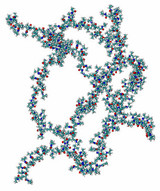Subproject A.4
Molecular Simulation of Hydrogels
|
|
Why do hydrogels swell and collapse?
Hydrogels are of great importance in nature and technology. Hydrogels are three-dimensional hydrophilic polymer networks, which swell up in water to a multiple of their self-volume. The industrial applications of hydrogels are various. They reach from baby diapers to the chromatographic cleaning of proteins and they will expand rapidly in the future. Different characteristics of the hydrogels are used in various applications: thermodynamic, mechanical and chemical, in which both the equilibrium and kinetics are of importance.
The work in the area of the investigation of hydrogels is predominantly experimental today. When modeling is used for the investigation, it is usually based on simple phenomenological approach or Coarse Grain models. Yet, the new and challenging applications require a deeper understanding of the processes in hydrogels, which is to be received only by a detailed analysis on the molecular level.
There are however still substantial difficulties in the application of molecular simulations of hydrogels. These difficulties result, above all, from the fact that spacious cooperative effects arise in the polymer network. Therefore, long ranges must be observed over long periods of time, in order to make reliable statements about the macroscopic behavior. Even more difficult is the fact that strong, long-range interactions play a substantial role in the behavior of hydrogels.
Further information about this subproject
This subproject was continued at the Technical University of Kaiserslautern until April 2008 and finished in June 2009.


